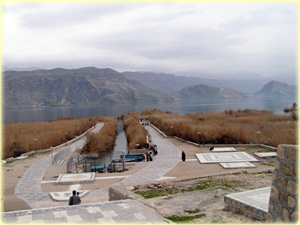|
Iran highlights
Lake Parishan and Dasht-e-Arjan
|
Site: Lake Parishan and
Dasht-e-Arjan |
Designation date:
23-06-1975 |
|
Coordinates: 29°30'N
052°00'E |
Elevation: 853 m - 2000
m |
Area: 6,200 ha
|
|
Location: Lake Parishan
and Dasht-e-Arjan are situated in the Province of Fars, in the Zagros
mountains, 40 - 80 km west of Shiraz and 15 - 25 km south of Kazerun.
|
|
 |
|
Importance: The wetland
of Dasht-e-Arjan is an outstanding example of a freshwater wetland,
characteristic of the highlands of western Iran. Lake Parishan is a good
example of a brackish to saline wetland, characteristic for the same
highlands. They support five species of threatened birds: Pelecanus
crispus, Marmaronetta angustirostris, Aythya nyroca,
Oxyura leucocephala and Aquila heliaca. Both wetlands
support a very diverse flora and fauna, and thus maintain the genetic
and ecological diversity of the region. In winter, the lakes hold over
20,000 waterfowl. They also support over 1% of the regional wintering
populations of Pelecanus onocrotalus, Phoenicopterus ruber,
11 species of ducks (Anatidae), Fulica atra, Grus grus and
Larus ridibundus. In breeding season large breeding colonies of
herons (Ardeidae) and ibises (Threskiornithidae) can be found at the
lakes, as well as over 1% of the regional populations for Plegadis
falcinellus and Platalea leucorodia. |
|
Wetland Types:
Ts ,Sp
,R
,Q
,O
,N
(dominant types shown in bold)
Dasht-e-Arjan and Lake Parishan
are two very different wetlands situated only 15 km apart. Dasht-e-Arjan
is a largely seasonal, shallow freshwater lake with extensive reedbeds.
The wetland varies widely in size from year to year depending on
rainfall, but two large springs on the western side maintain some
permanent marsh throughout the year. The surrounding flats are usually
covered by terrestrial grasses or remain as bare baked mud, but in wet
years sedges predominate. Lake Parishan is a shallow, brackish to saline
lake in the Zagros foothills. It is surrounded by marshes with
halophytic vegetation. It is fed by a number of permanent springs and
several seasonal watercourses. The salinity varies widely according to
the size of the lake. During the dry years of the early 1970s, the lake
was brackish to saline, and marsh vegetation was confined to the western
and eastern ends of the lake (near freshwater inflow). There were large
areas of bare saltflats in the southwest bay. Throughout much of the
1980s and 1990s however, water levels have remained high and the water
is now almost fresh. There are extensive reedbeds in many parts of the
lake. |
|
Biological/Ecological notes:
Dasht-e-Arjan is a eutrophic lake. The marshes around it comprise
extensive areas of reeds Phragmites australis and reedmace
Typha sp. with fringing areas of rush Juncus spp. and other
aquatic plants. Lake Parishan is an oligotrophic lake surrounded by
eutrophic marshes. It also supports extensive beds of reeds, as well as
halophytic vegetation like Salsola, Kochia, Camphorosma
and Halocnemum. Large areas of the semi-arid steppe around Lake
Parishan have been converted to wheat fields. Nearby mountainsides are
still covered with forests of oak, while the lower slopes are partially
covered with steppe forest of almonds, hawthorn and hackberry. In much
of the area, the shrub-like "Arjan" tree Amygdalus sp. is
conspicuous. Both Lake Parishan and Dasht-e-Arjan are extremely
important for waterfowl of a wide variety of species. Marbled teal
Marmaronetta angustirostris breeds at Lake Parishan when conditions
are suitable, and large numbers winter at the wetlands. The ferruginous
duck Aythya nyroca occurs in small numbers all year round, and
several pairs breed at Lake Parishan. The numbers of most other duck and
coot Fulica atra have been decreasing recently, presumably
because of increased disturbance by fishermen in motorised boats.
However, improved agriculture to the south of the lake now provides
better feeding habitat for greylag gooses Anser anser and crane
Grus grus. Water rail Rallus aquaticus, purple swamphen
Porphyrio porphyrio and Baillon's crake Porzana pusilla breed
in the marshes of Dasht-e-Arjan. Wintering raptors include white-tailed
eagle Haliaeetus albicilla, marsh harrier Circus aeruginosus,
imperial eagle Aquila heliaca, saker Falco cherrug and
barbary falcon Falco pelegrinoides. The great range of habitats
within the protected area supports almost the full range of species
typical for the montane steppe, pistachio-almond forest, oak forest and
wetland systems of the central and southern Zagros mountains, as well as
some species more typical of the Gulf coastal wetlands. Forty-four
species of mammals have been recorded in the protected area (which is
larger than the Ramsar site). |
|
Hydrological/Physical notes:
Dasht-e-Arjan lies enclosed in a basin. It is unusual in that it
drains out through a group of swallow-holes at its southeast corner. The
bottom consists of alluvial mud. Lake Parishan lies enclosed in a
drainage basin of about 29,000 ha in a broad valley between Zagros
ranges. The lake has a muddy bottom. The physiography of the region
comprises limestones that form spectacular escarpments, generally
aligned as parallel ridges enclosing broad valleys with oak woodland.
|
|
Human Uses: The area is
state-owned. Only a few activities have been recorded at the site. They
are subsistence fishing, reed-cutting and extensive grazing by domestic
livestock. The Ornithology Unit of the Department of the Environment has
carried out annual mid-winter censuses since 1967. There are plans to
build a visitors centre. This site is renowned for its spectacular
scenery. In the surrounding area there are a few small settlements with
orchards and gardens, some wheat cultivation and other crops.
|
|
Conservation Measures:
A national park of 65,750 ha was established in
1972, but at the end of the 1970s after the revolution it was downgraded
to a Protected Area of 52,800 ha. The area of the original national park
was designated a UNESCO Biosphere Reserve in June 1976.There is a game
guard station on a peninsula overlooking the western part of Lake
Parishan. At both lakes hunting has been prohibited since 1973. The
Ramsar Advisory Mission that visited the lakes in 1992 made several
recommendations. The most important are to demarcate the borders of the
site clearly with signs, and to prohibit any further drainage activities
at lake Parishan. |
|
Adverse Factors: Lake
Parishan is under considerable threat from various sources, while
Dasht-e-Arjan remains in reasonably good condition. Some 20 hectares of
marsh at the extreme northwest corner of Lake Parishan were drained for
agriculture about 20 years ago. Elsewhere around this lake, wet meadows
have been replaced by cultivated fields. A small area of fishponds was
established on the plains to the west of the lake in the early 1980s,
and it is reported that 3 species of carp have been introduced to the
lake. There has been a considerable increase in fishing activities, and
the widespread use of outboard motor boats instead of traditional
reedboats has resulted in disturbance to the waterfowl populations.
Poaching remains a problem, as well as the accidental killing of
waterfowl in fishing nets. At Dasht-e-Arjan poaching is also a problem.
Two sets of high-tension power lines that cross the lake are dangerous
to birds and are spoiling the beautiful scenery of the lake. One of the
lines has not been in use since it was constructed in the late 1970s.
|
|


![]()
![]()

